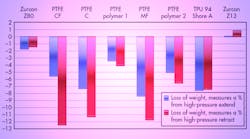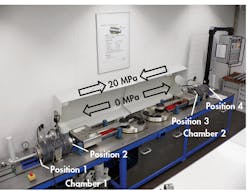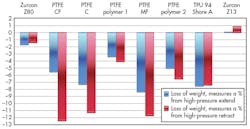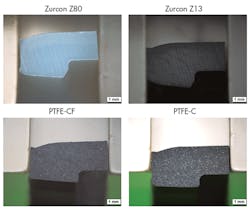This file type includes high resolution graphics and schematics when applicable.
Water-based hydraulic fluids are widely used in oil and gas, mining, hot-rolling mills, and similar applications where the potential for fire could cause catastrophic consequences. The International Standards Organization (ISO) classifies fire-resistant, water-based hydraulic fluids into four categories:
- HFAE, which includes oil-in-water emulsions, typically with more than 80% water content;
- HFAS, which are synthetic aqueous fluids, typically containing more than 80% water;
- HFB, which are water-in-oil emulsions typically containing more than 40% water; and
- HFC (also known as glycol solutions, polyalkylene glycol solutions, and water glycols), which include water polymer solutions, typically containing more than 35% water.
HFC fluids (water glycols) are the most commonly used fire-resistant hydraulic fluids in and are increasingly being used instead of HLP hydraulic fluids in hydraulic oil and gas applications with a high fire risk. Certain sealing materials are proven and traditionally used with HLP fluids. However, the different chemical makeup of HFC and HLP fluids means that seal performance will not necessarily be the same with both types of fluids.
Tests conducted at Trelleborg showed that sealing materials usually used with HLP media showed significantly higher wear in HFC fluids. In addition, choosing the right sealing material is further complicated by variation of water content in HFC fluids.
Water-Glycol Mixtures Complicate Sealing
Compared to other hydraulic fluids, the composition of water and glycol HFC fluids have a significantly higher ignition temperature due to their composition of water and glycol. This makes them suitable (sometimes mandatory) for applications with high fire risk.
The water content of HFC fluids can vary between 35 and 50%, and the tribological properties of the fluids change depending on water content. This fact leads to a fundamental problem in specifying a suitable sealing system that will meet length of life performance criteria.
Oil-and-gas hydraulic applications often involve a lot of motion—heave-compensation cylinders, for example. Due to long strokes, sealing systems can be subject to significant wear. Compared to oil-based HLP fluid, the water base of HFC fluids has limited resistance to wear. As oil and gas applications increasingly use HFC fluids and longer seal life is needed, we conducted research into the optimum sealing material for HFC fluids.
The Test Process
We conducted a series of tests on several materials to investigate the various influences and their effect on friction, wear resistance, and leakage in systems using HFC fluids. The HFC fluid chosen for the tests is one that has worked successfully in critical oil and gas applications.
The design of rod seals was held constant across all materials tested, which included proprietary polytetrafluoroethylene (PTFE)-based materials with various fillers, proprietary polyethylene, and proprietary polyurethane. We measured the reduction in the radial cross-section of the seal ring (w-measure) and the change in weight to determine the wear rates.
Two test benches were used—one to measure wear and another to measure friction. In positions 1 and 4, the hydraulic pressure as a function of the piston rod direction was reversed to duplicate what would occur in a rod seal in a differential cylinder. Positions 2 and 3 duplicate the behavior of rod seals in a plunger cylinder.
Pressure in relation to the direction of movement of the piston rod affects positions 2 and 3 and positions 1 and 4 differently. This leads to a difference in the lubricant film thickness, which has a substantial effect on wear rates. These relationships were confirmed when looking at weight loss together with dimension of the sealing profile contour. The PTFE-based materials show a greater deviation of wear dimensions.
The two materials that demonstrated the least weight loss (wear) were the proprietary compounds Zurcon Z80 and the Zurcon Z13. Measuring leakage from the cylinder showed that measurable leakage tended to increase at positions 1 and 4. No leakage was apparent only for seals made of the Zurcon Z80 and Zurcon Z13.
Visual inspection showed the best results were achieved with Zurcon Z13. Although the Zurcon Z80 showed slight extrusion after one million load cycles, no abnormality was observed with the Zurcon Z13 with the same seal geometry. The PTFE based materials were significantly worn after 200,000 cycles.
Summary and Outlook
During the tests, strong influences were observed in the behavior of the seals in relation to friction and wear. Due to the significant fluctuation of the mixing ratios (water/glycol) in HFC fluids and in operation, reliable behavior of sealing systems can only be predicted to a limited extent.
To ensure long seal life and performance in hydraulic systems, knowing the specific type of hydraulic fluid in service and using test results and experience allows matching the correct sealing material to the hydraulic fluid.
Despite the successful use of PTFE-based materials with HFC fluids, alternative sealing materials—such as Zurcon Z80 and, especially, Zurcon Z13—can offer better wear resistance for longer life life.
Dr. Mandy Wilke, Technology Specialist, Fluid Power Europe
Holger Jordan, Segment Manager, Fluid Power Europe
Trelleborg Sealing Solutions, Suttgart, Germany.
Looking for parts? Go to SourceESB.
This file type includes high resolution graphics and schematics when applicable.





